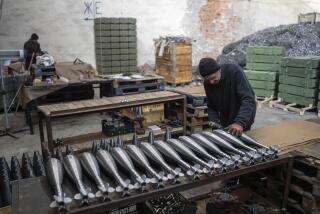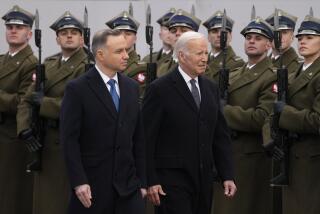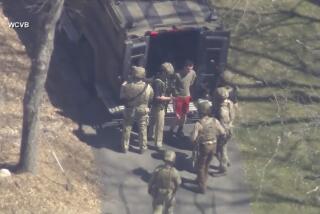Iraq Sought Poland’s Scrap for Edge
CZESTOCHOWA, Poland — Desperate for missile technology in the summer of 2001, Iraq’s arms brokers and spies homed in on the military scrap yards of this former Soviet Bloc nation. They operated out of this town, scavenging and assembling decades-old parts that were shipped to Syria, then trucked across deserts and mountains toward Baghdad.
Documents were forged and lies were told in an elaborate network built to evade United Nations sanctions.
The shipment of up to 380 missile engines from Poland was critical to Saddam Hussein’s covert program to extend the range of his new Al Samoud 2 missile beyond the limit of 150 kilometers -- 93 miles -- imposed on Iraq after the 1991 Persian Gulf War. Such capabilities would have threatened regional stability by enabling Iraq to target Israel, Kuwait and Iran.
The godfather of Iraq’s missile program, Modher Sadeq-Saba Tamimi, had for nearly a decade deceived U.N. weapons inspectors about illicit missile projects. But a year ago, as the United States geared up for war, the inspectors discovered the Volga/SA-2 engines smuggled from Poland.
Their existence was crucial evidence for the Bush administration as it attempted to convince a skeptical U.N. Security Council of the need to topple Hussein. Documents taken from Iraq’s military-industrial complex after the war and recently obtained by The Times reveal details about one of Baghdad’s primary weapons systems and why the Al Samoud 2 was a high-profile concern for Washington.
In his dramatic U.N. speech Feb. 5, less than two months before the March 20 invasion, Secretary of State Colin L. Powell highlighted Iraq’s procurement of the Volga/SA-2 engines as one reason for war.
“Their import was illegal,” Powell said of the engines, adding that the U.N. arms embargo prohibited “all military shipments to Iraq.”
The scheme to smuggle missile engines epitomized Iraq’s relentless quest to arm itself in spite of international sanctions. It shows how Baghdad often reconfigured its arsenal. Iraq, which had been firing Volga/SA-2 missiles at British and U.S. warplanes patrolling the “no-fly” zones in the north and south, also sought the missile engines to construct a modified surface-to-surface weapon.
In many ways, development of the Al Samoud 2 -- based on 30-year-old technology at a time when inspectors were looking for high-tech biological and chemical weapons -- was one of Hussein’s most dogged attempts to add muscle to his depleted armed forces. Hatched by the Military Industrialization Commission, the hub of Iraq’s military production, the engine deal was funded through a Jordanian bank, overseen by politically connected Syrians and carried out by Polish scrap dealers and a gritty collection of businessmen in the export trade.
Hundreds of pages of Iraqi military documents, bills, customs forms, ledgers and shipping orders obtained by The Times offer a rare peek into Hussein’s arms procurement network. They reveal that for much of its conventional weaponry -- such as the Volga/SA-2 missile engine -- Iraq turned to rusting military hardware in the former Soviet Bloc.
Companies in several of these nations, which were saddled with ruined and corrupt economies, were among the main suppliers to the global illicit arms bazaar.
In Poland, the arms merchants ended up focusing on a new member of the North Atlantic Treaty Organization and one of the relatively few European countries to support the Bush administration’s war plan.
The documents also show that as an international outcast, Iraq had to contend with a host of setbacks and frustrations involving funding, dishonest foreign suppliers and the search for reliable middlemen. Dealers had to trick U.N. inspectors and even navigate around complications in the aftermath of the Sept. 11 terrorist attacks.
On Feb. 28, 2002, for example, the Polish front company providing the missile engines wrote in a letter to the Iraqis asking for a contract extension: “We are forced to ask for this for reasons beyond our control. 1) The explosion of the World Trade Center on Sept. 11, 2001 in America, which led to a difficult situation all over the world, and 2) [Your] requests for additional materials are leading to a delay in delivery.”
The Polish deal comprised four contracts for up to 380 missile engines between January 2001 and August 2002.
Contracts were signed by three parties: Karama Co., located in a north Baghdad suburb and serving as Iraq’s principal missile development site; Armos Trading Co., one of Iraq’s procurement organizations that scoured the world for weapon-making materials; and a Polish firm known as Evax.
It is not clear whether Evax, which claimed to have two representatives in Baghdad, was a viable firm, or, as is often the case with the illegal weapons trade, a front company existing only on paper.
According to a June 28, 2001, contract, Evax would smuggle 96 Volga motors of “Eastern production” to Iraq for $1,263,360. Another contract, for $652,500, stated that Evax would deliver ventilation devices and valves for fuel and oxygen supplies. Evax and the Iraqis were confident that the Polish dealers could evade weapons sanctions.
“The embargo against Iraq is not considered an [obstacle] for the supplying Polish party,” said the June contract, written in Arabic. The following April, Evax’s Baghdad representative, Amir Ibrahim Jasim, wrote to Iraq’s Military Industrialization Commission of “spare parts and parts for motors that are sent from Poland through many different channels that cannot be detected by the enemies.”
Such stealth was what Karama needed to fulfill Hussein’s ambitions. Founded in 1990 to increase the range of Iraq’s Scud missiles, Karama was run by Modher, a missile expert who was once imprisoned by Hussein. Protected by high walls and barbed wire, the Karama compound was home to 30 research and production buildings. The site was bombed by the United States in 1998, but Karama continued production and built a new factory after the airstrikes.
According to U.N. inspectors, the Czech-educated Modher was creative in gathering arms. He oversaw scores of deals to smuggle weapons material into Iraq, including gyroscopes and accelerometers removed from Russian submarine-launched nuclear missiles that were being destroyed under arms control treaties. Jordanian authorities intercepted one illegal shipment. The botched deal landed Modher in prison after Tariq Aziz, then Iraq’s foreign minister, blamed him for the scandal.
Before his arrest in 1995, Modher, said to have enjoyed a good chat, provided bits of information in a game of shadows and fog with weapons inspectors. The inspectors’ insight into Iraqi procurement activities diminished when Modher went to prison.
“We always asked to talk to Dr. Modher,” said one former U.N. inspector. “We thought it might help keep him alive.” Modher was released from prison in 1998. “I saw him cry in front of me when they brought him out of jail,” the former inspector said.
Modher returned to Karama in 1999 to resume his long-term goal: building a new liquid-fueled missile, the Al Samoud 2. The plan took root in the 1970s, when Baghdad started importing rocket fuel and more than 1,200 Volga/SA-2s from the Soviet Union. The key to the new missile, whose name in Arabic means “endurance,” was to increase its range by adding engines.
The scope of Karama’s program came to light Dec. 7, 2002, when Iraq handed its 12,000-page weapons declaration to the U.N. Security Council. The files revealed that the Al Samoud 2 had flown beyond the U.N.-imposed 93-mile limit in 13 out of 40 test flights. One flight had reached 114 miles.
This information confirmed the CIA’s suspicions. In a report to Congress in early 2002, the agency had noted that four launchers for the Al Samoud 2 were spotted at an Iraqi military parade Dec. 31, 2000, indicating “that this liquid-propellant missile program is nearing completion.”
Part of the success of Karama’s clandestine missile program lay in the scrap yards of Poland, an economically depressed nation burdened with a bloated military after the Soviet Bloc collapsed in the early 1990s.
Over the last decade, the Polish army has shrunk to 140,000 troops from 400,000, and masses of military hardware have been relegated to scrap heaps and auction blocks. The nation’s Military Property Agency runs a Web site offering everything from T-55 tanks to 122-millimeter howitzers, Iskra jets and a submarine.
The Iraqis already were long-time customers of Eastern Europe’s weapons industries. Baghdad was intimate with gunrunners in Belarus and Ukraine. Yugoslavia provided Iraq with fuel tanks for MIG fighter jets. Russian companies had contracts to provide artillery barrels and radio equipment to Iraq’s intelligence service. Bulgaria received orders for 300 tanks, and there were requests throughout the region for 10 million blasting caps and 20 million Kalashnikov bullets.
From Poland, the Iraqis wanted the Volga/SA-2 motors.
Evax relied on a collection of scrap dealers and middlemen, including Slawomir Niezgoda, director of an import-export firm known as Matrix. According to Polish investigators and Iraqi documents, Niezgoda and other businessmen, several of Middle Eastern descent, collected Volga rocket parts from junkyards operated by the Military Property Agency. Police are investigating 15 suspects, including a government employee. One, identified as Moulem Hassan, is believed to be an Iraqi agent.
Under Polish law, only licensed dealers are permitted to sell sensitive military hardware. The engines Niezgoda and his associates recovered from scrap were later sold abroad, according to Poland’s Agency for Internal Security, even though Matrix “did not have a permit to sell products and technologies strategic for the security of the state.”
Niezgoda’s shipments of missile engine parts were detected by chance. In February, local officials were investigating Niezgoda for tax fraud. Police raided his Matrix office, run out of his two-story brick-and-stucco home at the edge of railroad tracks in Czestochowa, the site of Poland’s venerated Black Madonna Catholic shrine.
Niezgoda’s files led police to other businessmen, including a scrap dealer who decorated his office lot with the shell of a 30-foot Volga/SA-2 missile. Investigators were surprised at what they discovered in the cellars of two warehouses.
“We found 40 large military boxes containing scrap and parts of missile motors and missile steering equipment,” said Michal Cichy, a security agency investigator. “It’s not a simple task to collect all this. You have to shop for all the parts. These missile parts were manufactured in the 1960s and 1970s for Volga rockets.”
Niezgoda was arrested and jailed for seven months. He was released in September and is awaiting trial for allegedly exporting weapons-related materials without a license. Said his lawyer, Andrzej Rozyk: “The charges against my client are very weak. Mr. Niezgoda does not deal in weapons. It was scrap.”
Shipping documents obtained by The Times show that on at least two occasions -- in January and March 2002 -- Matrix delivered crates of missile engine parts, compressors and other materials to freighters bound for Syrian ports. One of the shipments was loaded onto the Rafaela, owned by Mediterranean Shipping Co. in Geneva. The shipment left the Polish port of Gdynia and stopped in Antwerp, Netherlands, before its long journey to the Syrian port of Latakia. A second shipment “said to contain 68 pieces engines gross weight 6,500 kilos,” according to the documents, was loaded onto the Madrid and followed the same route.
On April 11 of that year, Jasim, Evax’s representative in Baghdad, informed Iraq’s Military Industrialization Commission that a shipment from Poland was in transit.
“The third consignment arrived at the Syrian port of Tartous and is now on its way to the Karama Company. It comprises 32 motors for Volga/SA-2 rockets and 750 pieces of pressure valves, air valves and other materials,” he wrote.
An April 28, 2002, log entry from an Iraqi customs office shows that a shipment from Poland containing “192 technical devices” crossed by truck from Syria into Iraq at Qaim. Shipping documents were often altered and lies were told about the contents in efforts to deceive U.N. inspectors.
On May 19, the Military Industrialization Commission informed Karama that Iraq had notified “the National Bank of Jordan to settle the amount of $14,818.16 in favor of the Polish company, Evax.” The letter is signed by Jasim Ahmed Hassan, deputy minister of military production.
The middleman in the Polish connection was a Syrian company listed on shipping invoices and in Karama files as Scientific Technical Corp. The corporation wasn’t commonly used for arms deals. The bulk of materials reaching Iraq’s military sites, according to documents, was handled by SES International Trading Co., run by a cousin of Syrian President Bashar Assad, whose Alawite clan controls the Latakia port.
STC is a heating and air-conditioning firm operating out of a small downtown Damascus office with stained stucco walls. Owner Haitham Sabbagh, a heavyset man, wore a blue leather jacket during a recent interview and chain-smoked Davidoff cigarettes that seemed too slender for his hands. Sabbagh denied that STC ever dealt with the Iraqis or with Polish suppliers, even after paperwork related to the Polish deal and bearing his letterhead were presented to him.
“I never shipped anything to Iraq,” Sabbagh said. “I never accepted any money from Iraq. I was never in Poland and I never negotiated such a deal. I think what is happening is that some powerful people are using our names without our knowledge.”
When asked whether SES International was using STC as a front for its weapons deals, Sabbagh grew edgy. “You have a passport and can leave here,” he said. “I live here and have to go back to my family. I don’t want to speak of this anymore. What can I do about this? The people doing this are much bigger than I.”
SES representatives, including general manager Asef Isa Shaleesh, agreed to meet a Times reporter in Damascus, the Syrian capital. On the day of the interview, however, the reporter was told that Shaleesh was called to Romania unexpectedly. A date for a second interview was set, but that was also canceled because Shaleesh had flown to Russia. Since then, the company has not responded to faxes and e-mails.
Missile engine shipments bearing the STC stamp flowed across the Syrian-Iraq border until the brink of the U.S.-led invasion.
Karama informed Evax in a Jan. 17, 2003, letter that it had received and accepted 49 Volga/SA-2 motors. On Jan. 29, the Military Industrialization Commission informed its commercial branch to “take the necessary steps to pay the amount of $114,650 to the Polish company, Evax.”
Two days earlier and thousands of miles away, chief weapons inspector Hans Blix had told the U.N. Security Council that Iraq had imported 380 Volga/SA-2 missile engines. Iraq had a possible loophole, however. Companies shipping rocket engines violated the U.N. embargo, but once the engines were inside Iraq, they were legal unless fastened to a modified missile. Moreover, Iraq had admitted to possessing them and had turned over the contracts.
Modher insisted that the Iraqis were complying with U.N. regulations, even though some test missiles had flown farther than permitted. Iraq attributed the range to the missiles not being weighed down with payloads or guidance systems.
But after a meeting of experts, the Security Council declared that the Al Samoud 2 missile violated U.N. resolutions. Blix ordered the destruction of 76 missiles, 118 warheads and nine launchers.
By the time U.N. inspectors were withdrawn from Iraq in mid-March, they had overseen the destruction of 72 missiles and 47 warheads. “We were still unsure of what to do with those engines when we left Iraq,” a U.N. official said.
The world body is still assessing Iraq’s prewar intentions. A U.N. report dated Nov. 26 stated that the Al Samoud 2 was “inherently capable” of distances greater than the 93-mile limit and that Iraq could have further increased the missile’s range using several methods, including mounting Volga engines side by side, extending fuel tanks and allowing spent motors to drop off in flight. The U.N. did find that the Al Samoud 2 airframe diameter had been widened from 500 to 760 millimeters. Such an alteration would have enabled Volga engines to be mounted.
However, the U.N. report also noted that although missile-system research and development was “actively pursued,” the work “did not appear to be well advanced.”
Modher has been meeting in Baghdad with British and U.S. officials who are searching for the remnants of Iraq’s illicit missile arsenal.
Fleishman was recently on assignment in Poland. Times staff writer Alan C. Miller in Washington and special correspondent Ela Kasprzycka in Warsaw contributed to this report.
More to Read
Sign up for Essential California
The most important California stories and recommendations in your inbox every morning.
You may occasionally receive promotional content from the Los Angeles Times.












